► New Automobili Pininfarina Battista edition
► Designed to honour racing driver Giuseppe ‘Nino’ Farina
► Just five to be made, is second design edition
Automobili Pininfarina has unveiled a new special edition of its Battista electric hypercar: the Edizione Nino Farina. The new edition, of which just five will be made to this specification, is designed to honour Giuseppe ‘Nino’ Farina – nephew of Battista ‘Pinin’ Farina and the first-ever Formula One world champion. The Battista Edizione Nino Farina will make its public debut at the 2023 Goodwood Festival of Speed.
The new Nino Farina edition features bespoke Rosso Nino paintwork – a colour that looks like gloss upon first glance, but comes alive in the sunlight with a deep pearlescent tone. CAR spent some time with the new Nino edition with Automobili Pininfarina’s chief design officer, Davide Loris Amantea; ‘this is the colour of passion. The colour looks like a solid red inspired by the 50s racing cars but it has a particularly specific technique on how it’s sprayed that, at that time, didn’t exist.’
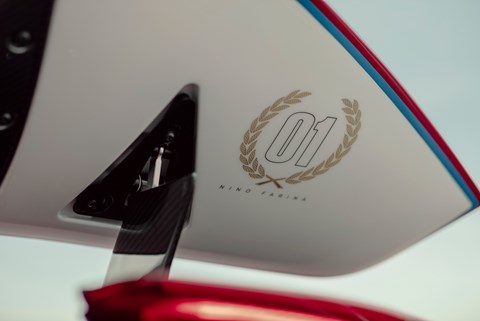
This electric hypercar’s livery is inspired by Nino’s racing car, and Amantea points out that Battista Farina ‘was the first to design cars with an instinct for colour and trim.’ So much so that the Edizione has a white painted lower valance to accentuate the Battista hypercar’s lines, as well as white panelling on the underside of the car’s massive rear wing, complete with a ‘Nino Farina’ signature. Other details include ‘Glorioso Gold’ wheels, ’01’ graphics and flashes of blue trim. To make each one of the five editions unique, the headlight trim will be embossed with one of five milestones from Nino’s life: his date of birth, his first pole and race victory at the 1950 British GP, his second win at the 1950 Swiss GP, his third victory at the 1950 Italian GP or his world championship victory in that year.
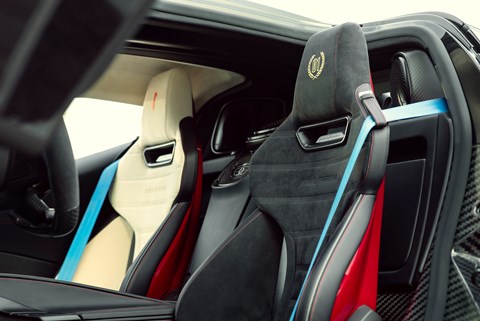
Inside, the theme continues with a black driver’s seat and cream passenger seat. More ‘01’ graphics can be seen in plaques honoring Nino around the interior, as well as a signature on the steering wheel.
‘He was really brave, and really skilled as a racing driver,’ says Amantea, speaking of Nino, ‘but he also was a classic gentleman driver. He was also very clever, and became a doctor during the Second World War. We decided that this story should take a better spot in our history – and it gave us the chance to realise an incredible story that our customers are looking for.’
Read more about the Automobili Pininfarina Battista below, or check out our review here.
Pininfarina Battista: the full story
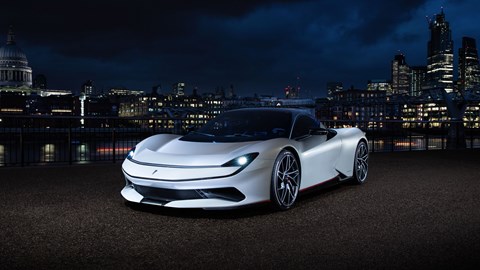
Powered by a Rimac-produced powertrain, the new Pininfarina Battista hyper EV produces 1874bhp, 1696lb ft of torque from four electric motors, and can launch from 0-62mph in under two seconds. If you can take it, the Battista will get you to 186mph from a standing start in under 12 seconds. Top speed is over 217mph. Pininfarina says the Battista can go for 280 miles between charges thanks to its 120KWh Li-ion battery pack. Yes, this is an all-electric car, remember.
But forget the numbers – take a look around the new Italian pin-up. The Battista looks like a thoroughbred Italian supercar. If it wasn’t for the lack of exhausts and engine on display, you’d expect to hear the growl of a naturally-aspirated V8 on startup. Where you’d usually find a viewing port for a fire-breathing powerplant, there’s simply a glowing Pininfarina badge. All this car’s power comes from its T-shaped Rimac powerplant, and there’s no cylinders or spark plugs involved.
It will have a distinct sound though. Pininfarina says the driver will be able to define their bespoke sound settings – though there won’t be any artificial sound amplification. Key factors in this signature sound will be the electric motors, air flow, HVAC system, and resonance of the carbon monocoque.
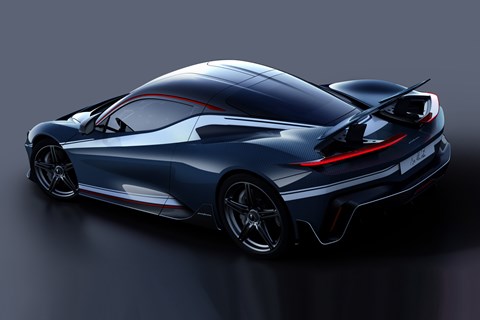
At the front, headlights – which look a little like those on the recently shown Ferrari F8 Tributo are linked by a striking light bar. Either way, it’s a stunning signature feature, and gives the car a futuristic, yet still classic, look.
Walk around the Battista, and you’ll find those sweeping lines we’ve come to expect from the Italian design house, and the ‘floating’ active rear-wing at the of the car is almost like a visual full stop. It’s integrated at lower speeds, but can pop up to increase downforce at higher-speeds, and even act as an air brake. It’s all a bit sci-fi.
All models will run on huge 21-inch rims smeared in Pirelli P-Zero rubber, and carbon-ceramic 6-piston brakes on the front and rear axles will get the Battista stopped. As this is still an EV, those brakes allow for energy recovery, eking out and reclaiming as much energy as possible.
Inside, it’s a driver-focused cabin with dual-screens either side of the steering wheel. To avoid being saddled with infotainment and connectivity that quickly dates – an issue that super- and hypercars too often suffer – Automobili Pininfarina looked at suppliers who can provide future-proof software and also wanted to make sure the passenger has a good time as well.
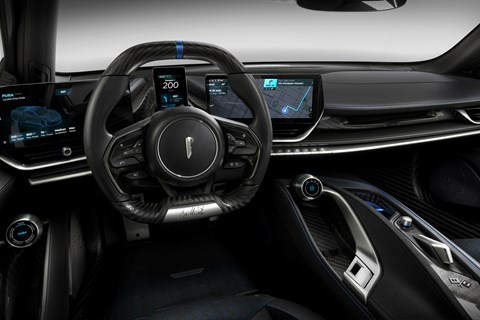
The hypercar’s 4WD underpinnings feature a Rimac-made T-shaped battery pack crammed between and behind the driver and passenger seats rather than below the floor. That way, the roof stays low and the major weight between the wheelbase for better handling. Originally, Pininfarina wasn’t keen to confirm the use of the Croatian start-up’s internals – but now the fact is featured in the Battista’s press release.
Pininfarina is keen to emphasise just how driveable this car should be despite its insane performance figures. As well as dialling down some of the reaction times of the EV’s powerplant, so it’s easier and more predictable to drive at lower speeds, the Italian marque also enlisted the help of the Mahindra racing Formula E team. That meant Nick Heidfeld helped make the Battista a little more manageable for its eventual owners.
With that in mind, the car features five drive-modes, and will also intelligently use its four electric motors for torque-vectoring; helping the driver get the most of the Rimac powertrain.